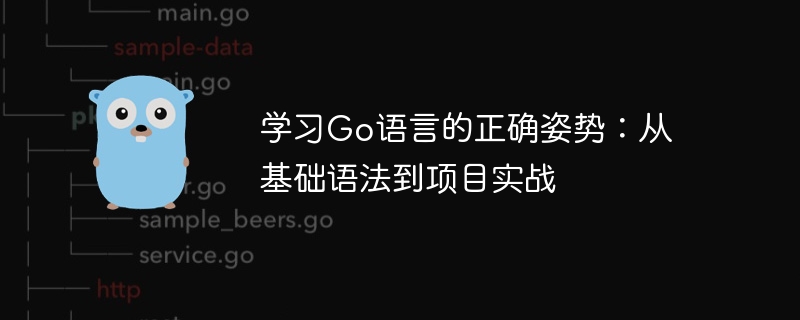學習Go語言的正確姿勢:從基礎文法到專案實戰
遵循結構化的學習方法對於學習Go 語言至關重要:掌握基礎語法,包括變數、資料類型、控制流程、函數和方法;探索內建套件和標準庫,提升語言能力;深入了解並發性和goroutine,提升程式碼效率;掌握進階概念,如指針、介面、反射和測試,拓展程式視野;透過專案實戰,將所學知識應用於實際場景,鞏固理解。

學習Go 語言的正確姿勢:從基礎語法到專案實戰
在學習任何程式語言時,遵循一種結構化的學習方法至關重要。對於Go 語言,這種方法如下:
基礎語法
- #變數定義和資料類型
- 控制流:條件和循環
- 函數和方法
- 內建套件和標準函式庫
- 並發性和goroutine
進階概念
- 指標和記憶體管理
- 介面和型別斷言
- 反射和元程式設計
- 測試和基準測試
專案實戰
理論知識需要透過實踐來鞏固。以下是一些適合初學者的專案實戰案例:
案例1:一個簡單的HTTP 伺服器
package main
import (
"fmt"
"log"
"net/http"
)
func main() {
http.HandleFunc("/", func(w http.ResponseWriter, r *http.Request) {
fmt.Fprint(w, "Hello, World!")
})
log.Fatal(http.ListenAndServe(":8080", nil))
}##案例2:命令列工具
package main
import (
"fmt"
"os"
)
func main() {
if len(os.Args) != 2 {
fmt.Println("Usage: ", os.Args[0], "<filepath>")
os.Exit(1)
}
filename := os.Args[1]
file, err := os.Open(filename)
if err != nil {
fmt.Println("Error opening file:", err)
os.Exit(1)
}
defer file.Close()
lines := 0
scanner := bufio.NewScanner(file)
for scanner.Scan() {
lines++
}
fmt.Println("File ", filename, " contains ", lines, " lines")
}以上是學習Go語言的正確姿勢:從基礎文法到專案實戰的詳細內容。更多資訊請關注PHP中文網其他相關文章!

熱AI工具

Undresser.AI Undress
人工智慧驅動的應用程序,用於創建逼真的裸體照片

AI Clothes Remover
用於從照片中去除衣服的線上人工智慧工具。

Undress AI Tool
免費脫衣圖片

Clothoff.io
AI脫衣器

Video Face Swap
使用我們完全免費的人工智慧換臉工具,輕鬆在任何影片中換臉!

熱門文章

熱工具

記事本++7.3.1
好用且免費的程式碼編輯器

SublimeText3漢化版
中文版,非常好用

禪工作室 13.0.1
強大的PHP整合開發環境

Dreamweaver CS6
視覺化網頁開發工具

SublimeText3 Mac版
神級程式碼編輯軟體(SublimeText3)
 c語言多線程的四種實現方式
Apr 03, 2025 pm 03:00 PM
c語言多線程的四種實現方式
Apr 03, 2025 pm 03:00 PM
語言多線程可以大大提升程序效率,C 語言中多線程的實現方式主要有四種:創建獨立進程:創建多個獨立運行的進程,每個進程擁有自己的內存空間。偽多線程:在一個進程中創建多個執行流,這些執行流共享同一內存空間,並交替執行。多線程庫:使用pthreads等多線程庫創建和管理線程,提供了豐富的線程操作函數。協程:一種輕量級的多線程實現,將任務劃分成小的子任務,輪流執行。
 Go語言中用於浮點數運算的庫有哪些?
Apr 02, 2025 pm 02:06 PM
Go語言中用於浮點數運算的庫有哪些?
Apr 02, 2025 pm 02:06 PM
Go語言中用於浮點數運算的庫介紹在Go語言(也稱為Golang)中,進行浮點數的加減乘除運算時,如何確保精度是�...
 Go的爬蟲Colly中Queue線程的問題是什麼?
Apr 02, 2025 pm 02:09 PM
Go的爬蟲Colly中Queue線程的問題是什麼?
Apr 02, 2025 pm 02:09 PM
Go爬蟲Colly中的Queue線程問題探討在使用Go語言的Colly爬蟲庫時,開發者常常會遇到關於線程和請求隊列的問題。 �...
 C語言中 sum 一般用來做什麼?
Apr 03, 2025 pm 02:39 PM
C語言中 sum 一般用來做什麼?
Apr 03, 2025 pm 02:39 PM
C語言標準庫中沒有名為“sum”的函數。 “sum”通常由程序員定義或在特定庫中提供,其功能取決於具體實現。常見的場景是針對數組求和,還可用於其他數據結構,如鍊表。此外,“sum”在圖像處理和統計分析等領域也有應用。一個優秀的“sum”函數應具有良好的可讀性、健壯性和效率。
 在 Go 語言中,為什麼使用 Println 和 string() 函數打印字符串會出現不同的效果?
Apr 02, 2025 pm 02:03 PM
在 Go 語言中,為什麼使用 Println 和 string() 函數打印字符串會出現不同的效果?
Apr 02, 2025 pm 02:03 PM
Go語言中字符串打印的區別:使用Println與string()函數的效果差異在Go...
 在Go語言中使用Redis Stream實現消息隊列時,如何解決user_id類型轉換問題?
Apr 02, 2025 pm 04:54 PM
在Go語言中使用Redis Stream實現消息隊列時,如何解決user_id類型轉換問題?
Apr 02, 2025 pm 04:54 PM
Go語言中使用RedisStream實現消息隊列時類型轉換問題在使用Go語言與Redis...
 GoLand中自定義結構體標籤不顯示怎麼辦?
Apr 02, 2025 pm 05:09 PM
GoLand中自定義結構體標籤不顯示怎麼辦?
Apr 02, 2025 pm 05:09 PM
GoLand中自定義結構體標籤不顯示怎麼辦?在使用GoLand進行Go語言開發時,很多開發者會遇到自定義結構體標籤在�...
 Go語言中`var`和`type`關鍵字定義結構體的區別是什麼?
Apr 02, 2025 pm 12:57 PM
Go語言中`var`和`type`關鍵字定義結構體的區別是什麼?
Apr 02, 2025 pm 12:57 PM
Go語言中結構體定義的兩種方式:var與type關鍵字的差異Go語言在定義結構體時,經常會看到兩種不同的寫法:一�...






